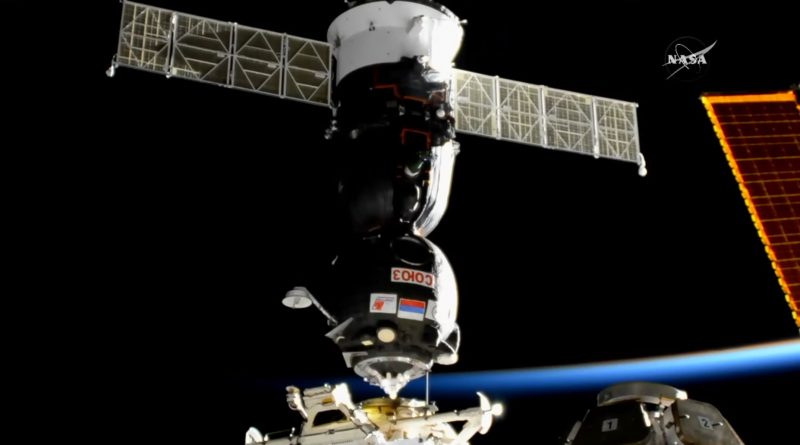Russian-U.S.-Italian Crew Trio Arrives at ISS after Express Soyuz Rendezvous
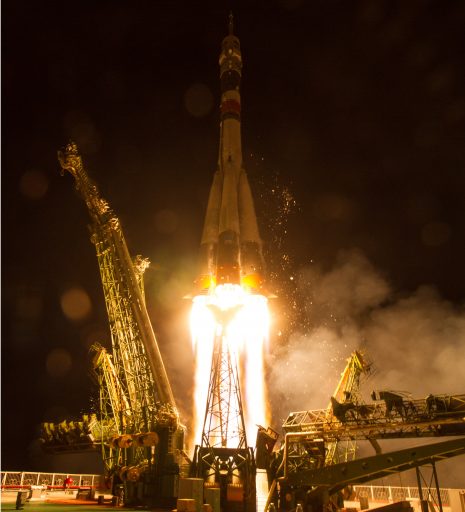
A Russian Commander and Flight Engineers from the U.S. and Italy lifted off from the Baikonur Cosmodrome at sunset on Friday, riding a Soyuz FG rocket into orbit to embark on an express rendezvous with the International Space Station that took them to their orbital destination just over six hours after launch.
Soyuz FG, carrying the Soyuz MS-05 spacecraft flying under the call sign Borei, blasted off from the historic Site 1/5 launch pad at 15:41:12 UTC on Friday, thundering into clear twilight skies under the power of its four liquid-fueled boosters and powerful core stage. The 49.5-meter tall rocket provided a spectacular sight as it dropped its four boosters two minutes into the flight followed not long after by the protective launch shroud that enclosed the spacecraft while flying through the atmosphere – falling away from the rocket to the backdrop of the expanding exhaust cloud from the core stage.
The all-veteran crew of Commander Sergey Ryazansky and Flight Engineers Randy Bresnik and Paolo Nespoli received a smooth ride as the Soyuz’s Block I upper stage assumed control of the flight four minutes and 45 seconds into the mission for the final push into orbit, separating the 7,300-Kilogram Soyuz spacecraft eight minutes and 48 seconds into the flight.
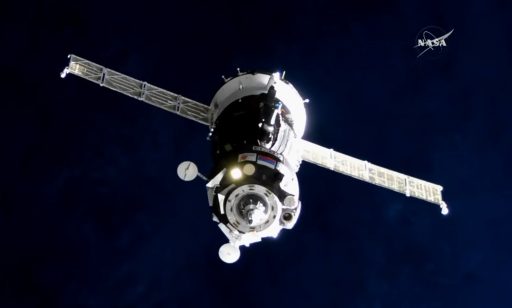
The 134th flight of a Soyuz spacecraft employed the accelerated six-hour rendezvous profile that aims to take the crew to the comforts of ISS after just four laps around the planet instead of the two-day trip previous crews had to make to reach their home in space. To that end, Soyuz was tasked with four orbit raising-maneuvers on its first two orbits around Earth followed by a fully automated rendezvous to set up for docking to the Station’s Rassvet Module at 21:54 UTC.
The three Soyuz MS-05 crew members were eagerly awaited in orbit by their Expedition 52 counterparts Fyodor Yurchikhin, Peggy Whitson and Jack Fischer who had the Station all to themselves since June 2 when the Soyuz MS-03 spacecraft departed the complex. The extended period of three-crew operations was caused by the need to switch the Soyuz #734 spacecraft originally intended by fly the MS-04 mission with the #735 vehicle that had been preparing to launch as Soyuz MS-05 due to a coolant leak discovered on the #734 vehicle during its processing flow.
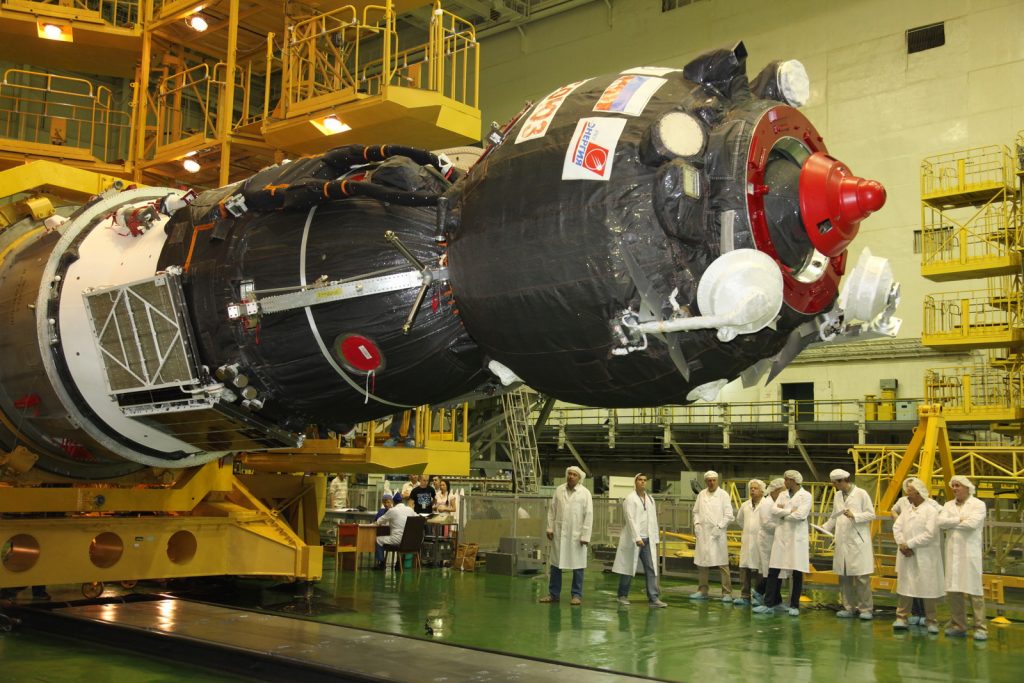
As repairs on Soyuz #734 were expected to take several months, the MS-05 mission had to be pushed by five weeks to accelerate processing on the #736 vehicle that had been earmarked for launch in September. Timelines were adjusted accordingly in order to re-join a regular Soyuz launch cadence by the end of the year which also meant the Soyuz MS-05 mission would be shortened slightly and move to a mid-December landing.
Soyuz #736 was put through an accelerated, but safe processing campaign and entered its final pre-launch flow on July 4 with a multi-day thermal vacuum checkout to ensure the integrity of its pressure vessel. The three crew members and their backups arrived at the remote Kazakh launch site on July 16 and participated in a checkout of their spacecraft the next day – first familiarizing themselves with the situation on board before completing a suited ingress exercise wearing their Sokol launch and entry suits. Soyuz MS-05 was then loaded with hypergolic propellants and pressurized gases before returning to the processing facility for its encapsulation in the protective payload shroud and a last pre-launch visit from the crew.
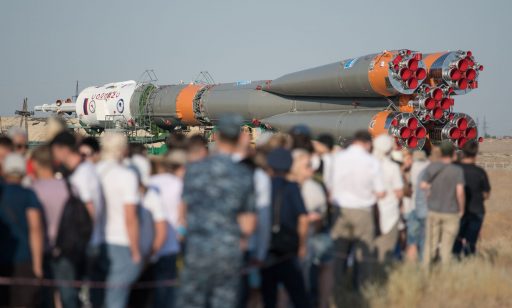
The Soyuz spacecraft was then shipped to the MIK Launcher Integration Facility where it met its rocket – the 60th Soyuz FG to take flight. The three-stage Soyuz emerged from its assembly hall on Wednesday at the traditional early morning hour to move to the Site 1/5 launch pad that supported over 500 space missions over the course of a six-decade service life including Yuri Gagarin’s milestone mission in 1961.
With Soyuz standing tall on its pad, engineering teams began preparing for an eight-hour countdown while the crew members enjoyed some final rest days before a long initial flight day and busy ISS mission as part of Expeditions 52 and 53.
Soyuz MS-05 is piloted by an experienced crew of three, all of whom have made at least one prior visit to the International Space Station.
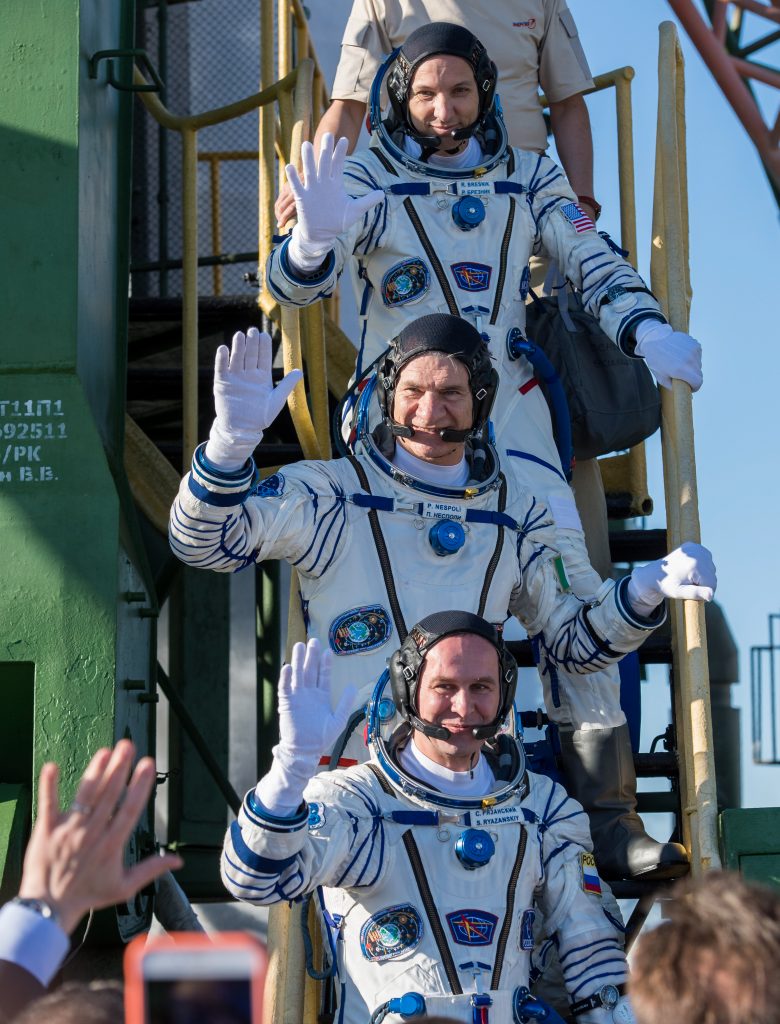
Sergey Ryazansky started his career in biochemistry, studying the effects of prolonged exposure to space on the human body and specializing in the development of countermeasures. He completed basic cosmonaut training from 2003 to 2005, presented his PhD thesis in 2006, and participated in the first two stages of the Mars 500 experiment, spending 15 and 105 days under isolation in the preparatory stages for the 520-day main experiment that simulated a trip to Mars and the effects it would have on the social-psychological interactions of a crew.
Ryazansky launched into space the first time in September 2013, spending 166 days in orbit as part of the Expedition 37/38 crew, also accumulating 20 hours and 5 minutes of spacewalking time on three EVAs.
Soyuz Board Engineer #1, Randy Bresnik, is a retired Colonel in the U.S. Marine Corps who flew combat missions in Iraq and served as a test pilot before being selected by NASA in 2004 as part of the agency’s 19th Astronaut Group. He received his first flight assignment as a Mission Specialist on the STS-129 mission of Space Shuttle Atlantis – spending 10 days and 19 hours in space, including a week-long stay at ISS to facilitate the delivery of two Express Logistics Carriers and three EVAs, two of which Bresnik participated in. On Flight Day 7, Randy Bresnik became only the third Astronaut to become a father while in space.
ESA Astronaut Paolo Nespoli served as a pilot in the Italian Army & worked in astronaut support before being selected in 1998 to become an Astronaut for ESA. He flew on Space Shuttle Discovery in 2007 for 15 days, facilitating the delivery of the Harmony module to the Space Station. His first long-duration mission was with ISS Expedition 26/27 in 2010/11, bringing his total to 174 days spent in space. Now 60 years of age, Nespoli aims to boost his total time spent off the planet to over 300 days; his mission as part of Expedition 52/53 is named ‘Vita’ in an ESA tradition of assigning a name for flights of their astronauts.
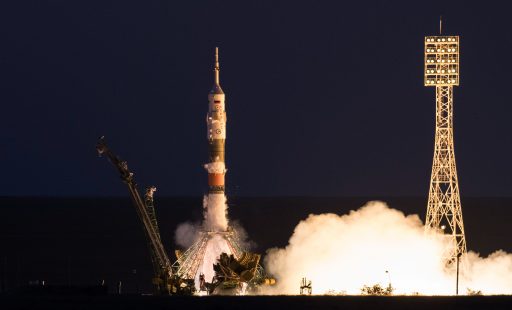
Friday’s Soyuz launch was preceded by a very smooth countdown – as has become the norm at Baikonur where launching humans into space has become a finely tuned machine over the last 56 years. Soyuz completed initial activation and testing before the State Commission gave the green flight for propellant loading – a two-hour sequence picking up five hours prior to liftoff to fill the rocket with Liquid Oxygen and Kerosene propellants as well as Nitrogen to pressurize the tanks during flight and Hydrogen Peroxide to power the booster and core stage turbopumps.
The three crew members arrived at the pad two and a half hours before liftoff to take their seats atop some 274 metric tons of explosive propellants – Sergey Ryazansky took the commander’s seat in the center with Bresnik to his left and Nespoli to the right, setting up for an hour and a half of pre-launch tasks before the countdown got quiet for them. While music was pumped into the capsule via comm loops to entertain the crew, engineers closed out the rocket, finished leak checks on the Soyuz and lowered the large Service Structure halves at the T-40-minute mark.
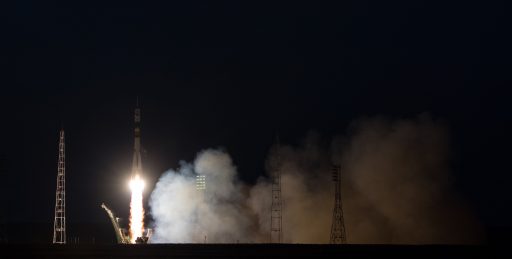
The countdown entered its automatic sequence at T-6 minutes to pressurize the 12 tanks aboard the vehicle, purge the engines with Nitrogen, and hand power/command over to the Soyuz FG. Flames erupted from the base of the vehicle at T-20 seconds and lit up the scenery around the launch pad as the sun had set 21 minutes prior to liftoff time.
Soyuz soared to a launch thrust of 422 metric ton force, overcoming counterweights to lift off the ground and begin its trip into orbit. Liftoff was marked at precisely 15:41:12:285 UTC and Soyuz quickly ascended back into direct illumination by the sun – setting up a spectacular show for all that had gathered at the launch site.
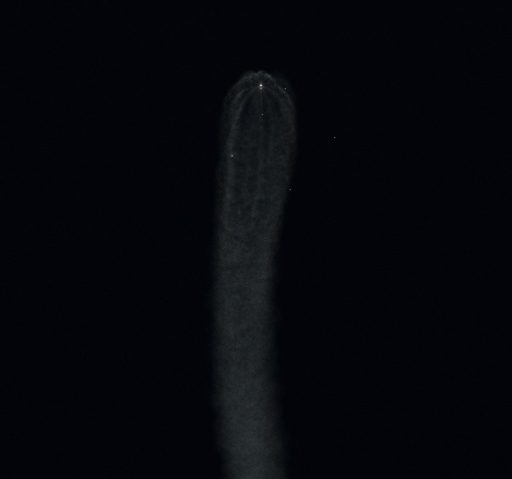
Turning toward the north-east, Soyuz began chasing down the Space Station that had passed directly over the launch pad some two minutes prior to liftoff. One minute and 58 seconds after launch, Soyuz shed its four boosters after each burned close to 40 metric tons of propellant to help accelerate the rocket to 1.5 Kilometers per second. Lighting conditions were extremely favorable for the Korolev Cross to become visible – a split second phenomenon named after the father of the R7/Soyuz design that is seen as the four boosters rotate outward from the still-firing core stage in the center.
With the boosters on their way to a rough landing 350km from the launch pad, Soyuz continued its ascent powered by the Block A core stage alone, generating 102 metric ton force of thrust with its four-chamber RD-108A main engine along with four steering thrusters that kept Soyuz on course. Soyuz separated its two payload shroud halves 157 seconds into the flight and tracking cameras at Baikonur showed the brightly burning core stage and small dots of light behind it as the boosters, escape tower and payload shroud fell back toward Earth.
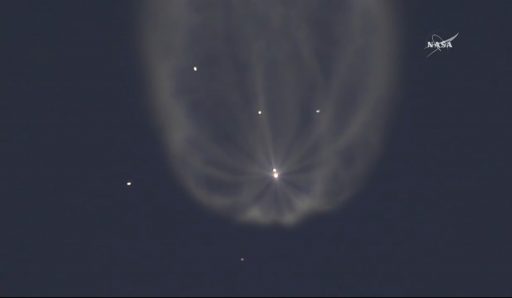
Onboard cameras showed the familiar jolt when the Core Stage shut down four minutes and 45 seconds into the flight to mark the start of the hot-staging sequence that handed powered flight off to the RD-0110-powered Block I third stage after the core burned 91 metric tons of propellant and lifted the stack to an altitude of 160 Kilometers.
The third stage delivered a rock-solid performance – generating 30,400 Kilogram-force of thrust to push the Soyuz into orbit. The three crew members were again jolted forward as thrust from the powerful engine cut out within a fraction of a second and faded into the sensation of microgravity. Soyuz MS-05 separated from the booster eight minutes and 48 seconds after liftoff and successfully deployed its two power-generating solar arrays and navigation antennas – sailing off on its express trip to ISS.
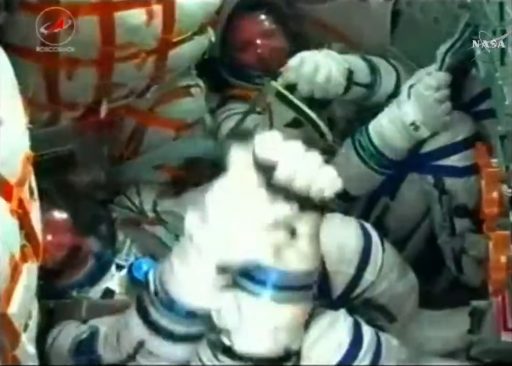
Mission Control Moscow reported shortly after launch that Soyuz MS-05 entered an orbit of 197.5 by 242.6 Kilometers, inclined 51.66 degrees and had begun maneuvering per its planned flight plan. This plan called for a pair of pre-programmed engine burns on the vehicle’s first lap around the planet to begin the process of spiraling up toward the Space Station’s 400 x 408-Kilometer orbit as soon as possible after launch.
The second orbit was to include another two engine burns that were re-calculated based on the craft’s actual insertion orbit parameters to put Soyuz into position for the initiation of the Automated Rendezvous Sequence on Orbit 3.
This sequence comprised a final ground-targeted engine burn that put Soyuz sufficiently close to ISS to begin collecting relative navigation measurements through its KURS radio navigation system.
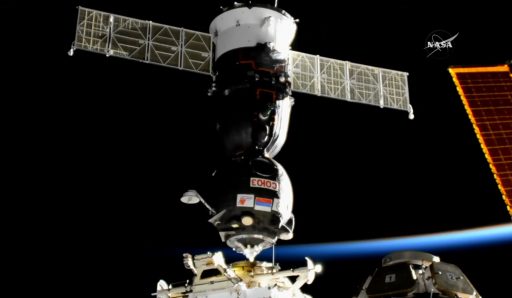
Through a series of impulse maneuvers, Soyuz linked up with ISS – initially targeting a point one Kilometer from ISS to keep a passive abort option in play until the late stages of the rendezvous when Soyuz moved up to 400 meters for an elaborate flyaround maneuver that lined the vehicle up with the Rassvet Module for a straight-in final approach that commenced after a short period of stationkeeping.
Soyuz MS-05 made a safe & on-time docking at 21:54 UTC on Friday while passing 402 Kilometers over Germany, capping a six-hour and 13-minute transit from the Kazakhstan launch pad to the crew’s orbital workplace for the next four and a half months. After a hard mate is formed between the Rassvet module and Soyuz, the crew will put in motion the typical leak check that will consume around 90 minutes to verify the seal between the two craft is holding pressure.
Hatch opening, scheduled for 23:40 UTC, will enable the two crews to greet one another – topping up the Station’s crew at six following an extended three-crew period.
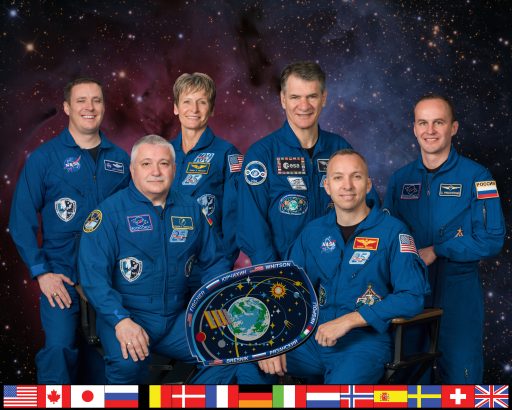
The six Expedition 52 crew members will only have five weeks as a joint crew with a number of operations planned in August such as a pair of reboost maneuvers on the 9th and 25th, the arrival of the Dragon SpX-12 cargo craft on the 16th (TBC) and a Russian spacewalk on the 17th that will see Fyodor Yurchikhin and Sergey Ryazansky venture outside the station for six hours to complete tasks on the exterior of the Russian Segment and deploy five small satellites.
Dates may move due to the fluid nature of the current launch situation at Cape Canaveral and the requirement to have Dragon approach ISS either before or at least two days after the release of the microsatellites.
The crew of Soyuz MS-04 will bid farewell late on September 2 for an overnight return to Earth, aiming for a parachute-assisted landing in the Kazakh steppe in the early hours of September 3. Their landing is expected to be followed just ten days later by the launch of Soyuz MS-06 with crew members Aleksandr Misurkin, Mark Vande Hei and Joe Acaba.

